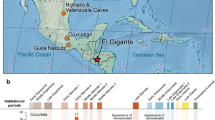Abstract
A sample of 535 specimens of cucurbits were retrieved from archaeological deposits in the Viru Valley, Peru, from contexts dated between ca. 1800 B.C.– 1100 A.D. by Carbon-14 analysis and cultural associations. Cultivars ofCucurbita maxima Duch. and C.moschata (Duch.) Duch. ex Poir. are found to be restricted, respectively, to early and late chronological periods, with no overlap. Cultural and ecological factors are suggested to account for the observed temporal and spatial variations in species occurrence. Comparison of materials from other coastal valleys indicat es significant, but presently unexplainable, spatial and temporal differences in the distribution of these species. Supportive evidence for South America as an independent center of domestication for C.maxima tis offered.
Similar content being viewed by others

Literature Cited
Carter, G. F. 1945. Some archaeological cucurbit seed from Peru. Acta Amer. 3: 163–172.
Cohen, M. 1977. The Food Crisis in Prehistory. Yale Univ. Press, pp. 215–217; 227–228.
Hurd, P. D., E. G. Linsley, and T. W. Whitaker. 1971. Squash and gourd bees (Peponapis andXenoglossa), and the origin of the cultivatedCucurbita. Evolution 25: 218–234.
Lanning, E. 1967. Peru Before the Incas. Prentiss-Hall. p. 53.
Larco Hoyle, R. 1938–39. Los Mochica, I and II. Lima.
Shimada, I., and M. Shimada. 1976. Resource exploitation and management at Pampe Grande, Lambayeque, Peru. Paper presented, annual meeting of the Amer. Anthropol. Assoc, Washington, D.C.
Towle, M. 1952. Appendix 2. Descriptions and identification of the Viru plant remains.In Strong, W. D., and C. Evans. Cultural Stratigraphy in the Viru Valley Northern Peru: The Formative and Florescent Epochs. Columbia Univ. Press, pp. 352–356.
West, M. 1977. The Viru Valley culture history model: A reassessment. Paper presented, annual meeting of the Amer. Anthropol. Assoc. Houston.
Whitaker, T. W., and H. C. Cutler. 1968. Pre-historic distribution ofCucurbita L. in the Americas-unsolved problems. Actas y Memorias del XXXVII Congreso Internacional de Americanists. Buenos Aires. Tomo II: pp. 511–515.
—, and J. Bird. 1949. Identification and significance of the cucurbit materials from Huaca Prieta, Peru. Amer. Mus. Novit. 1426: 1–15.
Author information
Authors and Affiliations
Rights and permissions
About this article
Cite this article
West, M., Whitaker, T.W. Prehistoric cultivated cucurbits from the Viru Valley, Peru. Econ Bot 33, 275–279 (1979). https://doi.org/10.1007/BF02858253
Received:
Accepted:
Issue Date:
DOI: https://doi.org/10.1007/BF02858253



